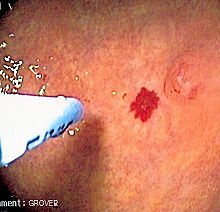Plasma medicine
Plasma medicine is the general term for the use of physical plasmas for therapeutic purposes . It is a comparatively new and interdisciplinary field of science at the interface between physics , medicine and biology .
Possible areas of application for plasmas in medicine include, for example, the disinfection or sterilization of medical products , body surfaces and living tissue , influencing wound healing , blood coagulation and tissue regeneration , the treatment of skin diseases and inflammatory diseases , use for incisions in the Surgery and the surface modification of medical implants with the aim of controlling their interaction with the surrounding tissue and in particular improving their ingrowth after implantation. There are used low-pressure plasmas of various compositions.
Most of these applications are still in the experimental and preclinical research stage. Experience from clinical practice has so far been limited to individual case reports or small case series . Therapy devices that use cold plasma for disinfection and wound healing were previously only approved for use in scientific studies.
Devices that have been approved under the Medical Devices Act have been available since 2013 . The medical electrical device can thus be placed on the market as an approved plasma medical product. The use on humans is possible in all medical practices by any medical professional. It generates cold plasma directly from the surrounding atmosphere, which contains reactive radicals which, in conjunction with low levels of ultraviolet radiation, destroy the cell walls of bacteria or the envelopes of viruses . To guarantee a high safety standard, the device was developed for operation without a mains connection and tested by the VDE for electromagnetic compatibility . A germ reduction of up to 99.9 percent has been proven in clinical studies .
National Center for Plasma Medicine
In June 2013 the National Center for Plasma Medicine Association was founded in Berlin , a Germany-wide network of all research groups in the field of plasma medicine. The network serves the purpose of "promoting research and development in the field of plasma medicine across Germany".
literature
- Gregory Fridman, Gary Friedman, Alexander Gutsol, Anatoly B. Shekhter, Victor N. Vasilets, Alexander Fridman: Applied Plasma Medicine. In: Plasma Processes and Polymers. 5/2008. WILEY-VCH, pp. 503-533, ISSN 1612-8850
- Mounir Laroussi: Low Temperature Plasmas for Medicine? In: IEEE Transactions on Plasma Science. 37 (6) / 2009. IEEE Nuclear and Plasma Sciences Society, pp. 714-725, ISSN 0093-3813
- Michael G. Kong, Gerrit Kroesen, Gregor E. Morfill, Tetyana. Nosenko, Tetsuji Shimizu, Jan van Dijk, Julia L. Zimmermann: Plasma Medicine: An introductory Review. In: New Journal of Physics. 11/2009. IOPscience, doi : 10.1088 / 1367-2630 / 11/11/115012 , ISSN 1367-2630
- Sacha Campbell, Ruby Alexander-Lindo, Tara Dasgupta, Donovan McGrowder: Gas Plasmas and Plasma modified Materials in Medicine. In: Journal of Applied Biomedicine . 8/2010. University of South Bohemia, České Budějovice, pp. 55–66, ISSN 1214-021X
- Klaus-Dieter Weltmann, Eckhard Kindel, Thomas von Woedtke, Marcel Hähnel, Manfred Stieber, Ronny Brandenburg: Atmospheric-pressure Plasma Sources: Prospect Tools for Plasma Medicine. In: Pure and Applied Chemistry. 82 (6) / 2010. International Union of Pure and Applied Chemistry, pp. 1223-1237, ISSN 0033-4545
Web links
Individual evidence
- ↑ First German plasma pen conquers hospitals. ( Memento from August 30, 2013 in the web archive archive.today ) Press release Leibniz Institute for Plasma Science and Technology June 6, 2013
- ↑ plasma-medizin.de Presentation of the association.
